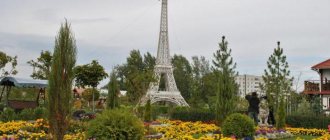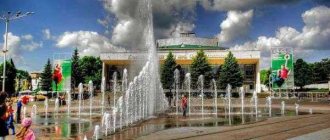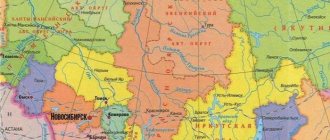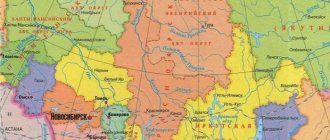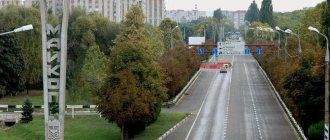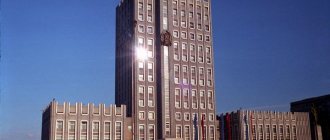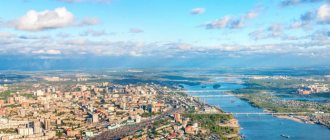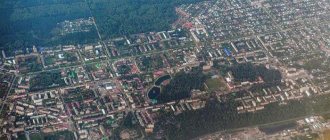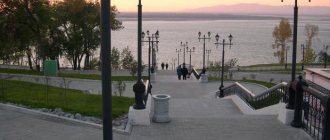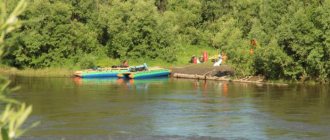History and geographical location
In 1709, Peter I issued a Decree, according to which the Bikatunsky fort was required to be founded at the confluence of the Biya and Katun rivers. This task was completed. The Bikatun fort was founded to protect the southeastern borders and trade routes of the Russian Empire. In subsequent years, the fortress was destroyed, restored, and rebuilt several times. At the end of the 17th century it was elevated to the rank of “regular” cities. This is how Biysk appeared.
Several centuries have passed since its founding. During this time, the city turned into a large industrial and scientific center. It has an advantageous geographical location. Biysk is located in the southeastern part of the Altai Territory. Barnaul is 163 km north. This is the capital of the Altai Territory. Near the city there is the confluence of the Biya and Katun. Water resources are used in the housing and communal services sector, agriculture, industry and tourism. Rivers have a negative impact during spring floods. The areas of Biysk located next to them are slightly flooded during this period.
Biysk on the map of Russia: geography, nature and climate
If you look at a map of Biysk from a satellite, you can see that the city lies on both banks of the Biy River, between which there are 3 bridges. The right part is characterized by meadow terrain, while the left part, lying in a lowland, is adjacent to a pine forest. Relative to the regional center - Barnaul, Biysk is located 163 km southwest. The closest borders are with Mongolia (617 km) and Kazakhstan (210 km).
Biysk is located in a zone of temperate continental climate in a forest-steppe zone, but this territory is characterized by severe cold winters and hot summers. Studying the topographic map, it becomes clear that severe frosts are explained by the location in the funnel between mountain ranges, which contribute to a decrease in precipitation and weakening winds in the area. The lack of wind also affects high temperatures in summer, increasing the amount of precipitation during this period.
- The average temperature for the year is 3 °C, the maximum is +38.9 °C, the minimum is 51.8 °C.
- Average air humidity – 71%
- Average wind speed – 2 m/s
Climatic conditions
The climate of the city of Biysk is sharply continental. It is characterized by the following features:
- cold winter with stable snow cover;
- short dry spring with late return of cold weather;
- short warm summer;
- short autumn with early frosts.
Snow cover usually forms in November-December. At this time the temperature is about –15 °C. January is characterized by severe frosts. The lowest temperature this month was recorded in 2001. It was –51.8 °C. In February, frosts give way to winds. In March the snow begins to melt, and in April everything gradually dries out. The first grass and leaves appear on the trees in May. Hot days begin in June and July. The highest temperature was recorded at the end of July 2012 – +38.9 °C. In August the mornings become cool. During the day the temperature is quite comfortable. With the beginning of September comes autumn. The average temperature this month is about +12.2 °C, and in the next month it is only +3.8 °C.
Train Station
Biysk railway station is a station in the Altai region of the West Siberian Railway, which is the terminus on the line from the Altaiskaya junction station. Type of railway station - passenger and freight. The railway station is located at st. Shukshina, 9. Opening hours: every day from 5:00 to 24:00.
The railway station receives and sends long-distance trains to the following directions: Novosibirsk, Moscow, Krasnoyarsk, Alma-Ata. Suburban trains are also serviced at the railway station.
Economy of Biysk
The economy of the city of Biysk has one peculiarity. The locomotive of its development is the industrial complex. It is developing at an accelerated pace. Among the existing enterprises in the city are:
- Biysk oleum plant. Operating since 1965. Manufactured products include industrial explosives, sulfuric acid, and civil goods. The plant has many awards. One of his achievements is victory at the all-Russian competition “Best Russian Enterprise” among enterprises of the military-industrial complex.
- Biysk Boiler Plant. Its history began back in 1942. The main activity is the production of steam and hot water boilers of low and medium power, boiler and auxiliary equipment for municipal and industrial energy.
- Biysk fiberglass plant. It was founded in 1991. Today the plant produces fiberglass reinforcement, construction dowels, fiberglass rods for polymer electrical insulators, sports equipment, etc.
Hymn
We will share a song for happiness with you. Let everyone pull up in any distance. Let's all celebrate our beloved city on the Biya River together today. A dazzling solar disk floats to the sound of the bells and the blue sky. We glorify the son of Russia tirelessly, We glorify our city named Biysk! And Biysk rushes up into the floors, And the winds sleep on the roofs of centuries. It has been dear to all townspeople since birth, placed here by Decree of Peter. A dazzling solar disk floats to the sound of the bells and the blue sky. We glorify the son of Russia tirelessly, We glorify our city named Biysk! We raised today's Biysk like an eaglet, seeing it off with hope. To the glory of Siberia, to the glory of Russia, to your glory, our great people! A dazzling solar disk floats to the sound of the bells and the blue sky. We glorify the son of Russia tirelessly, We glorify our city named Biysk!
Words by S. Inozemtsev, music by M. Aparnev.
Approved by the City Duma on October 23, 2008.
Altai biopharmaceutical cluster
In the city of Biysk, which has the status of a science city, there are pharmaceutical companies that produce unique medicines with antiviral, immunomodulatory, and anti-inflammatory properties. On the basis of these enterprises, the Altai biopharmaceutical cluster was formed. The partnership allows us to implement innovative projects in the field of production of medicines, sanitary and hygiene products of a new generation.
The Altai pharmaceutical cluster includes leading enterprises of the Russian market of pharmaceutical products and dietary supplements:
- CJSC "Altaivitamins";
- JSC "Evalar";
- JSC "Vostokvit";
- small and medium-sized businesses, etc.
Routes on the map of Biysk. Transport infrastructure
The settlement is connected with other cities by the following roads:
- “Chuysky tract” or highway P256 - The road connecting the Russian Federation with Mongolia was built before the First World War.
- Highway 01K-05 of regional significance of the Altai Territory Biysk - Martynovo - Eltsovka - border with the Kemerovo region. Part of the former regional highway R-366 Biysk – Martynovo – Kuzedeevo – Novokuznetsk with a length of 286 km. On the territory of the Kemerovo region it continues with the regional highway 32R-176 Biysk - Martynovo - Kuzedeevo - Novokuznetsk with a length of 84.9 km.
- Regional road 01K-11 of the Altai Territory Biysk - Karabinka - border of the Altai Republic.
- Regional road 01K-06 Biysk - Belokurikha.
- Highway 01K-10 of regional significance Katunskoye - Krasny Yar - Altaiskoye - border of the Altai Republic. Previously it was part of the R-369 Biysk-Altaiskoye-Cherga highway. Old Chuisky tract.
There is a railway through the city, it is marked on the map with a dotted line, the local station of which is the end point; trains depart from it daily to Moscow, Krasnoyarsk, Novosibirsk and other cities.
There is no airport in the city; the nearest airport is in Barnaul, which is served by express trains.
The bus station is located next to the railway station, on Vasily Shukshin Square.
In the city, municipal transport is represented by buses, served by 38 individual entrepreneurs and three legal entities, and electric transport, which runs on 18 routes.
Educational field
Biysk is a city where decent educational institutions are located. They make it a major educational center in the south of the Altai Territory. A significant higher educational institution in the city is the Biysk Technological Institute (a branch of the Altai State Technical University). It was founded in 1959. Today the university is a modern institution with six faculties. Scientific activities are actively developing there. Both teachers and students participate in the development of innovative projects.
Another university in the city is Altai State Humanitarian and Pedagogical University named after. Shukshina. It has existed since 1939. The goal of this university is to train specialists in education and the social sphere of a new type. In addition to universities, Biysk has a variety of technical schools and colleges that train workers and mid-level specialists.
What kind of technology park will be built in Biysk
The initiator of the creation of a technology park in Biysk was. The new complex will be located 1.5 km from its production base. Its area will be more than 12 thousand square meters. meters. Specialized laboratories and a production base with modern pilot-industrial equipment will be built here. Priority areas are the production of dietary supplements and packaging.
Construction is scheduled to be completed in 2023. The project initiator will be able to spend 250 million rubles from the federal grant in the current and next years. Co-financing of the Altai Territory will amount to 5 million rubles. The remaining amount – about 310 million rubles – is private investment.
December 02, 10:07
The first Altai technopark will open in Rubtsovsk in 2022
500 million rubles for the development of the technology park were allocated from the federal budget under a program providing for the creation of such sites in the country
Now, Karlyuk said, AltaiBioTech is at the stage of selecting a contractor and obtaining a construction permit.
Back in August, at a meeting on the development of the chemical industry in the region, Alexander Karlyuk said that the main goal of the project was to create conditions for “finding common ground” between large businesses and residents. Including through the construction of a multifunctional building in which products will be produced with control at every stage - from the procurement of plant raw materials to the release of finished forms.
According to Karlyuk, this will be the first technology park in the country created on the basis of a pharmaceutical company.
State of Medicine
It is impossible to be a modern and successful city without developed healthcare. In a science city it is at the proper level. Clinics and state-owned hospitals provide medical care to people in the city of Biysk. It is especially worth noting that the procedure for making an appointment with a doctor is now being improved. They are actively introducing modern technologies. For example, you can now sign up for the Biysk Consultation and Diagnostic Center remotely through the public services portal.
There are many private medical clinics in the city that operate legally and have all the necessary documents for medical activities. Dental clinics and offices are actively developing. In private clinics, modern materials, the latest equipment and new technologies are appearing, allowing for better treatment.
Which residents will enter the site
Now AltaiBioTech is talking about seven potential residents. Among them is , which plans to produce special packaging for medicines and dietary supplements according to GMP standards (a system of special stringent requirements for the production of medicines and supplements). Altaiplast also plans to engage in packaging. I intend to produce dietary supplements.
Previously, TASS reported that residents’ revenue by 2025 is planned at 1.5 billion rubles. And approximately the same amount of taxes will be transferred by residents to budgets of different levels by 2031.
Places worth visiting
Museum of Local Lore named after. V.V. Bianki is the place in the city of Biysk where you can get to know the history of the settlement and its cultural heritage. The institution was opened in 1920. One of the founders was V.V. Bianchi. It is his name that the museum bears today. The work of this institution began with the receipt of several collections from the zemstvo government and the natural history office of the Altai People's University. Subsequent work made it possible to increase the number of exhibits.
Today, the museum’s collections contain collections of stuffed animals and birds of Altai, herbariums, unique collections of weapons, samovars, shamanic tambourines and other interesting items. Important documents of the past, works of artists from Biysk and the Altai Territory are offered to visitors. The museum has a special music and exhibition salon. It regularly hosts interesting evenings, lectures and concerts, festive events, and thematic excursions.
For lovers of performances and acting productions, a city drama theater has been created in Biysk. The prehistory of this institution began back in 1887, when Narodnaya Volya member L.P. Yeshin organized the first theater group of lovers of dramatic art. This later led to the creation of the theater. The official date of its foundation is 1939. Today the theater stages performances for both children and adults. A special advantage of the institution is the availability of a variety of costumes and decorations. They provide a high aesthetic level of theatrical productions.
Biysk: from the center to the outskirts. Part II
Any city, like a person, is born, grows, develops... It has its own childhood, adolescence, youth, maturity and old age. Biysk, in our opinion, can be classified as a mature city. He already has his own history and experience, but he is still far from old age. What the city looked like 100 years ago and what it is like today.
From Knyazevka to Riviera
A place in the lowland along the bank of the Biya, where one of the most densely populated areas of the city is now located, was once overgrown with marsh grass and bushes (hence the name of the area - Green Wedge), and the Knyazevka River flowed parallel to the Biya. The first buildings in this place appeared in the 1880s - it was a small oil mill. Then the bourgeois Ivanova built a tannery here.
The area began to be populated in 1893, when the former Vladimir peasant Vlas Rybakov built the first steam distillery in Biysk on the Green Klin. Besides this plant, only four enterprises in Biysk district had steam engines. For renting land (5 dessiatines 470 square fathoms) Rybakov paid the Imperial Cabinet a round sum.
At the beginning of the 20th century, another large enterprise appeared here - a steam roller-grill mill of the legendary merchant Elena Morozova, equipped with the latest technology. It provided 41% of net profit from turnover and was in first place among all industrial enterprises in the county.
And in the western part of the Green Wedge, in the area of what is now Zalineinaya Street, there was a kerosene warehouse for the largest oil-industrial company of the Nobel brothers, which had warehouses and trade in many cities of European Russia and Siberia.
It is known that when the question of building a People’s House arose in the city, Rybakov proposed building it on the Green Wedge. But Anton Kopylov’s point of view won, and the People’s House, the current drama theater, was erected in the center of the city. So the Green Wedge, which had a chance to become a “cultural and leisure” center of Biysk, lost it and for a long time remained an undeveloped and provincial working outskirts where workers, migrants and other poor townspeople settled.
The new life of the Green Wedge began at the very beginning of the 1980s. Here, since 1972, soil reclamation was carried out, as a result of which the area slightly rose and became inaccessible to the Biya floods, after which large-scale housing construction began. In the 90s of the last century, it almost stopped, but in 2007, a large shopping and entertainment complex “Riviera” was built on Zelenka, as the townspeople call this area.
The steam roller mill of merchant Elena Morozova stood in first place among the industrial enterprises of the county. Early 20th century
Several years ago, a new one began to be built on the territory between the station and Green Wedge microdistricts. According to documents, it was called “Venice”. More than a dozen houses of nine and twelve floors were expected to rise by the end of the 2000s. But the developers’ plans changed and there was only enough money for one and a half high-rise buildings. Today, construction equipment is working again in the microdistrict. There is hope that new houses will appear there. A kindergarten with 300 places has already appeared and the construction of a modern secondary school has begun. Across the street is the largest grocery hypermarket in the city. Until recently, the area under the retail facility was a swampy wasteland, flooded by groundwater. Now only archival photographs can remind us of this.
And if the residents of the private sector of this microdistrict cannot get rid of underground water, the dam now reliably protects their houses from flooding. The long-awaited protective structure appeared in 2016. It was built within the framework of the federal target program “Development of the water management complex of the Russian Federation.” The events of 2014, when about one and a half thousand buildings were damaged by a devastating flood, are still fresh in the memory of the townspeople. The new dam is capable of holding a seven-meter rise in water. The authorities of Biysk plan to build a bypass road for motor transport on the engineering structure.
The appearance of the Green Wedge has been changed by new high-rise buildings on Sovetskaya Street, built for young families and immigrants from dilapidated and dilapidated housing. This year, construction of a park will begin behind the shopping and entertainment center. The vacant lot will be developed using funds from the national project “Housing and Urban Environment”.
Village by the lake
Two districts - Mochishche and the village of chemists - are located in the north-west of the city between Vasiliev and Trofimova streets and are adjacent to the mountain from the north, and to the industrial zone from the west.
At the end of the 19th century, in the area where the Mayakovsky tram ring is now located, dachas for city residents with a horse farm and an apiary were built. The place was nicknamed “Gromykhalovka”. All because there was a dacha for the Gilev merchants. They loved noisy parties and rattled glasses around the clock.
Closer to the mountain, in the area of the tunnel and the brewery, peasants settled. The settlement was named Garden, but among the people the name Mochische became more popular - from the soaking of hemp necessary for weaving ropes. They soaked hemp in a large lake that stretched from what is now Donskoy Lane to Udarnaya Street. The dimensions of the lake were about 100 m wide and up to a kilometer long. There were fish here, which were caught with nets in the summer. Spring waters flooded the area, so until 1934 the coastal part of the lake was not populated.
The rope production located next to the current tunnel made Mochische and the adjacent lake famous throughout Europe. One of the village artisans, a certain I.V. Bachurin, invented a twisting machine, which was exhibited at the Paris World Exhibition in 1900 and was awarded a gold medal. Bachurin planned to open a training and demonstration workshop in Mochishche for the production of twine and flax and hemp products. Even after the war, there was a “Ropemaker” artel in the village, where they wove horse harnesses, sewed collars, and rolled pimas.
The new life of Mochische began in 1953, when construction units arrived here for the construction of the Biysk industrial zone. In 1956, the village of Mochishche became part of the city and merged with the Northern Village of Chemists. Deforestation and drainage of swamps reduced Mochishchenskoye Lake, and after Lake Kruglenkoye was lowered into Biya, it dried up completely. In the 70s, attempts were made to revive it as a vacation spot for chemists, but they were unsuccessful. The Palace of Culture, built in 1963, became the real cultural and leisure center of the chemists' village.
The Progress Stadium was built two years later. For Biysk residents it was the central place of sports. The stands of the structure could accommodate up to ten thousand spectators. In the early 90s, the stadium passed from city ownership into private hands and within 30 years fell completely into disrepair. Last year, by the decision of Biysk deputies, the former “Progress” again became municipal. They plan to build an ice skating rink on its territory. As our publication previously reported, the design documentation for the future construction has already passed the state examination.
The Palace of Culture became the cultural and leisure center of the chemists' village. 70-80s of the XX century
The most important area
The history of the area within the boundaries of Vasiliev, Matrosov, Kutuzov and Socialist streets, known as the First Section, dates back to 1953, when it was decided to create construction and installation department No. 122 in the system of the Ministry of Construction of Metallurgical and Chemical Enterprises. The choice of ministry officials fell on Biysk, which in the near future was destined to become a major center of the defense industry. And in a few years, a vacant lot on the western outskirts of Biysk turned into a new urban area.
For the first two years, construction battalions played the main role in the construction of the new area, and then Komsomol members from Moscow and Leningrad became the main workforce. It is sometimes even difficult for our contemporaries to imagine the enthusiasm of the youth of those years - more than two thousand young men and women from large capital cities went to a small provincial Siberian town only after hearing about the large-scale construction projects planned here. Already in the fall of 1953, the first houses of the K-7 and K-9 types were erected on the edge of the forest - it was in these houses that most of the builders of the First Section lived. The following year, the first enterprises of the industrial zone were founded - a chemical plant and CHPP-1.
In August 1955, independent construction sites were organized as part of Trust No. 122 - from the first to the tenth. The first site was intended for the construction of a temporary village of standard houses, including a boiler room. The formation of the entire team depended on this site, according to the recollections of former high-ranking party worker Anatoly Vlasov. Therefore, the entire area was later named after the first site.
The construction site was often visited by major officials from Moscow, and ministers also visited. In 1954, the Minister of Defense Industry Dmitry Ustinov visited here. Later, the secretary-typist of the director of the trust, Anna Berdyugina, recalled how Ustinov, while climbing construction sites, tore a button with meat out of his coat. “I had to look for the same one, sew it on and clean the coat from cement dust.” Of course, Anna then could not even suspect that she was sewing a button on the future Marshal of the Soviet Union and Minister of Defense...
The residential area of the First Section gradually expanded: construction workers started families, had children, and kindergartens and a school appeared in the area. In 1958 - streets. In 1961, the first large-panel 4-story building in Altai was erected on the First Plot on the street. Lomonosova, 67. And the cultural center of the area became the Palace of Culture of Builders (now DKiS BOZ).
New facilities built in that part of the city include the Yubileiny stadium. It appeared in our city in 2012, on the occasion of the anniversary of the Altai Territory. Hence the name. The structure is equipped with a field heating system, and several dozen CCTV cameras are located on the territory. The stands can accommodate about four thousand fans.
First section. 60s of XX century
Today there are no two-story houses left in the neighborhood. Instead, high-rise buildings are springing up like mushrooms. Hundreds of young families who received certificates under the program of the same name settled in the new buildings.
In 2009, the famous builders’ park was decorated with a bright children’s playground called “Childhood Island”. It was presented to the city by supermodel Natalia Vodianova. Then more than 5 thousand people gathered for the opening of the gaming town. The park is closed today. The Biysk authorities recognized the site as dangerous for citizens due to its deterioration.
The only school No. 34 in the microdistrict has acquired an updated appearance. This year the educational institution will celebrate its 65th birthday. An excellent gift for the occasion was the school’s victory in the competition for municipal grants. Now there will be a much-needed stadium here. It is noted that the site can be used not only for conducting lessons, but also for passing GTO standards.
From the forest edge - straight to the stars
The AB district, located southwest of Kutuzov Street and Pribytkov Lane, is one of the youngest in Biysk. After the decision was made in 1958 to create a new defense industry enterprise in Biysk - NII-9 (later - ANIIHT, NPO Altai, FSPC Altai), a so-called village of scientists began to be created in a pine grove on the banks of the Biya workers of this plant. At first it was divided into two quarters, designated AB and VG. Over time, the name of the first quarter stuck with the entire village.
In 1961, the first streets appeared here - Radishcheva and Dekabristov. And later, the area was decorated with the Zarya sports complex, built using the folk construction method and training a whole galaxy of sports masters and Olympic champions (biathletes Sergei Chepikov and Vlada Belyutina, gymnast Yuri Pogromsky, divers Mikhail Chernov and Alexander Nechitailo) and a cinema (now a youth center) “ Motherland." Finally, in the 1980s, the Biysk Planetarium opened at AB, one of the few planetariums in Russia located beyond the Urals, and the second in the Altai Territory after Barnaul, and in 1991 the Biysk Lyceum, which is constantly included in the top hundred best schools, accepted its first students. Russia.
The AB microdistrict, like the First Section, has attracted the attention of developers. Work on the construction of high-rise buildings is in full swing here today. The increasing number of residents has influenced the development of infrastructure: a new school is being built, the building of the speech therapy kindergarten has been restored.
Biysk Planetarium. 80s of the XX century
Biysk residents call the square in front of the AB shopping center one of the most favorite places for walking in this part of the city. Two years ago, a lighted pedestrian fountain appeared here, so far the only one in the entire science city. It was presented to the residents by the famous philanthropist Yuri Nikitin. In winter, the area in front of the shopping center is decorated with glowing ice slides and pillars with bright ball lanterns. Such a fabulous atmosphere brings together not only residents of the neighborhood, but also guests from all over the city.
AB is a real paradise for lovers of an active lifestyle. A few years ago, a track for cyclists and roller skaters appeared in the forest behind the Zarya sports complex. And in the winter of 2022, an illuminated “Health Route” with a length of about seven kilometers was opened.
The article was prepared using materials from the funds of the Biysk Museum of Local Lore. V.V. Bianki and with the assistance of the director of the Museum of History of the Altai Spiritual Mission Pavel Kovalenko.
City attractions
Biysk is a modern city with a huge number of shops, shopping centers, entertainment, but it also has historical places and cultural attractions. Monuments and ancient buildings can be found in almost every district. Most of the attractions are concentrated in the historical center. In this area of the city of Biysk there is a park named after. Garkavogo is a favorite place of many townspeople. Here you can admire the equestrian monument to Peter I. It was installed in 2010. Nearby is a sculpture of Peter and Fevronia, which is a symbol of long and faithful love, a strong family.
The most important and important attraction of the city is the square in memory of the heroes of the Great Patriotic War with an eternal flame. About 25 thousand Biy residents defended their homeland from the fascist invaders. Unfortunately, half of the people were not destined to return back to Biysk - our fellow countrymen died on the battlefields.
Coat of arms
The coat of arms of Biysk is presented in the form of a French shield. It is divided horizontally into two equal parts. At the top is the Tomsk (vicarious) coat of arms. On a green field there is a silver horse galloping to the left of the viewer. The animal embodies power and rapid development.
At the bottom there is a golden mountain on a blue background. In its depths there is a shaft and drifts of a mountain mine. They symbolize the territory's richness in mineral resources and their processing.
The regulation on the coat of arms of the municipality was approved on March 28, 2008 by the City Duma.
Interesting buildings
In the old center of the city of Biysk on Sovetskaya Street there is a marvelous architectural structure - the majestic white stone Assumption Cathedral. The first work on its construction began at the end of the 19th century. The building was made in pseudo-Russian (Byzantine) style. The erected temple functioned until 1932. Then it was closed for several years. Grain was stored in the building during this period. The re-opening of the church took place in 1947. Today the cathedral is operational.
It is impossible to tell about all the interesting buildings, because there are so many of them. Let's take a closer look at the building of secondary school No. 4 in the city of Biysk, the photo of which is presented below. This educational institution with the status of a school was opened in 1904 by order of Nicholas II in the historical part of the city (Kazanka). In 1911, the educational institution acquired a new building on Arkhiereyskaya Street (now Shevchenko). During the war, an evacuation hospital operated here, as evidenced by the memorial plaque. Today the building houses a school. In 2004, it celebrated its centenary.
At first glance, Biysk seems to be a simple and unremarkable city. In reality this is not the case. Today it is considered the locomotive of innovative development of the region and the country as a whole. Important enterprises and organizations operate there, there are effective educational institutions, and history and culture have been preserved. The administration of the city of Biysk will do everything necessary for its development. Systematic work will make it possible to preserve and effectively use production, scientific and technical potential, and create comfortable conditions for the life and creativity of city residents.
Entertainment
Biysk Planetarium
Address: st. Socialisticheskaya, 2/1 Phone: Website: https://rodina-biysk.ru/index.php/planetarium Opening hours: Mon-Fri 09:00-17:00 Cost: children—70 rubles, adults—130 rubles.
Residents of Biysk call their planetarium a “dome”, the reason for this is the shape of the building in which it is located. Its premises are decorated with images of the night sky and scenes of space exploration.
In the windows, instead of ordinary glass, stained glass windows with panoramas of galaxies are installed. In the halls there are models of spaceships made by students of the local astronomical club.
The equipment was donated to the planetarium by the first cosmonauts who trained here. The devices were brought from Germany, from the Zeiss plant. Yuri Gagarin learned to navigate in outer space using them.
Using the telescope, visitors can see more than 6,000 stars at an altitude of 500 kilometers.
